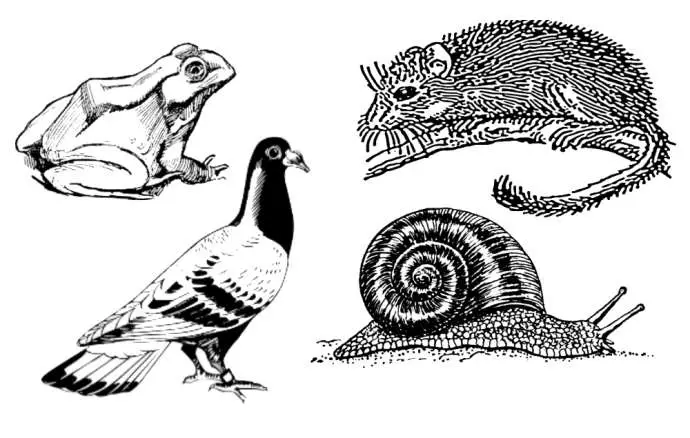January 10, 2019
If you ever wondered about the source of the Slovenian expression “bolje vrabec v roki kot golob na strehi” (better a sparrow in the hand than a pigeon on the roof), here’s a hint in a 1982 cookbook on the tricks of “our grandmothers”:
“In bourgeois houses, housewives would prepare a feast with the following menu: frog soup, cooked snails, sparrow risotto, and roasted pigeons. Before the First World War, these specialties were on offer at the Zvezda restaurant in Ljubljana, where our grandfathers liked to go to enjoy these delicacies.”
(Pavle Hafner, Ta dobra stara kuha, Pečeni golobi, 1982, p. 132)
Although sparrow risotto recipe is mentioned it’s not included in this recipe book, and in fact we had difficulties finding any sparrow recipes elsewhere, Valvasor’s 1799 cookbook included. However, there are still quite a lot of recipes that use ingredients, particularly those from the animal kingdom, that are hardly common or even considered as edible today.
As suggested in the quote above, the big changes in traditional cooking did in fact occur no earlier than in the second half of the 20th century, when the so-called second wave of globalisation affected not only the ways of life in the Old World, but also the world in general. And its effects, due to cultural exchanges and the consequences of the environmental degradation following the process of industrialisation, sooner or later revealed themselves on every person’s dining table. Traditions were thus forced to reinvent themselves at a very rapid pace.

Kazina (1932), Congress Square in Ljubljana , the location of Zvezda restaurant where most of the dishes below were served long into the 20th century
Kazina today
In this article, we take a look at some of the meat dishes that used to be served at bourgeois dining tables long into the 20th century, but are either not as common now or completely gone from “traditional” Slovenian cuisine.
- Frog legs.
Although frog legs remain a delicacy that can still be found in a handful of restaurants across Slovenia, Pri Žabarju (At the Frog Hunter’s http://prizabarju.si/en/ ) being one of them, they are far from as common as they used to be. The Ljubljana marshes, for example, used to present an abundant source of frogs and their legs, which at least since the beginning of the 16th century could be found at the city fish market, located at today’s Fish Square in Ljubljana.
In the abovementioned book, we find several frog leg recipes, including one for a frog soup, which goes like this:
“In spring, when frog hunters began hunting frogs, our mother often cooked us frog soup. Us, the kids, appreciated fried frog legs more, but our father preferred the soup. There’s lots of work with frog soup, as its preparation is quite demanding.”
For the vegetable stock finely chop the listed vegetables and boil them in two litres of water for about with an hour, with the addition of some salt, ground pepper and nutmeg.
We stir fry the frog legs in fat and then add the vegetable stock to the pan. Then we add the chopped green parsley and cook for another 15 minutes.
The soup is served with toasted buns.
- Pigeon roast
Pigeons used to be farmed in the cities and countryside, and were prepared in various fashions, including roasts, stews and risottos. Here is a recipe for pigeon stew from the Hafner’s 1982 cookbook we’re using for this story.
We clean the pigeons and rub in the salt and leek. We cover their breasts with bacon and tie them with a string. We roast the pigeons in hot lard. In a separate pan we put the butter, chopped onion, chopped bacon, chopped parsley and chopped sardine fillets. Lightly stir fry these and add salt. We then pour in the beef stock and white wine and let it all simmer. Then we add the roasted pigeons and lemon. We stew until the meat is soft. We serve the pigeons in the pot they were stewed in.
- Stuffed garden snails
Although most of the people I know consider land snails as a non-food, they still appear to be quite a popular delicacy, especially in Europe, albeit less so today than they used to be. In Slovenia, garden snails used to be picked in spring, when they were still sealed and hibernating and their digestive organs empty. If we pick them later, they first need to be starved, which according to Hafner usually takes two days. We put the snails in the fridge so that they retract into their shells and seal themselves. When closed we place the animals into boiling water and cook for 20 minutes. After this first boil, we extract the snails from their shells and remove their bowels – apparently these organs will be easy to see and extract at this point. Then we put them in a strainer and sprinkle with rough sea. We then rinse them until all the slime is gone.
The cleaned snails should now be cooked, continues Hafner, in a soup made of chopped carrot, half an onion, thyme, pepper berries, and root parsley. We can also add some white wine, vinegar or lemon juice and salt. In this soup we cook the snails for about an hour, depending how big they are. If we are going to use the shells, they first need to be thoroughly cleaned using hot water and soft brush.
We prepare garlic butter with parsley, stirring finely chopped garlic and parsley leaves into butter and adding some salt. In each of the snail shells we add a teaspoon of soup then push a snail in and seal the opening with the garlic butter. We place stuffed snail shells in a pan and bake them in a hot oven for about five minutes. We serve them hot.
Some special utensils are used when eating this dish: a scissor-like tong for holding the snail, a small fork which we use to get the snail out of his or her shell and a small spoon, where we pour the soup from the shell.
- Barbecued dormouse
Dormouse hunting has been popular in Inner Carniola for centuries, and the first historic account of the practice dates back to the 13th. Dormice used to be an important source of fat, protein and fur, and the original reason for hunting them was survival. Today, however, the main goal of polhanje as dormouse hunting is called in Slovenian, is not in catching a dormouse, but rather in the continuation of a tradition which mainly remains as a fun social event.
In Hafner’s book we read that “we hunt dormice in the late fall. The traps are placed on old beech trees and in pear orchards. Gourmets know well what a treat roasted dormice are. However, one needs to know how to prepare them properly. There are two ways to prepare them: on a barbecue or in a pan.”
Dormice are barbecued in the open air, after we have caught them. A skinned dormouse is threaded on an iron skewer, with a snow pear and a slice of bacon pushed into its belly. Sprinkle the animal with salt and pepper and place on the barbecue. Since dormice are hunted when they’ve stuffed themselves getting ready for winter, you have to pay attention so that the fat doesn’t catch fire.
- Boiled crayfish (Astacus astacus)
Crayfish used to be quite a popular dish in Slovenia, and it would still be so if the domestic varieties had not been depleted by duck plague 140 years ago, which was brought to Europe by the American invasive variety Signal crayfish, that is immune to the disease but spreads it. On top of this the number of autochthonous crayfish varieties are also shrinking due to human interference with their habitat, whether by water pollution or replacing the waterbeds with concrete floors. This is why crayfish hunting is banned in Slovenia, at least as far as the local varieties are concerned, and the recipe below, written in 1982, serves as a stark reminder of the consequences of environmental degradation and how it can change our diets:
“Two kinds of crayfish live in our streams, European or noble crayfish (jelševec) and stone crayfish (koščak). Jelševec is of a much better quality, since it is bigger and tastier.
We first clean the crayfish with a brush and then boil them while still alive. We heat a pot of water with a parsley root and some leaves in it. Before we place a crayfish into the boiling water, we pick it up by its back with our left hand and with the thumb and index finger of our right hand we hold the middle fin of its tail, rotate it and pull out. This way we remove the crayfish’s guts. We then boil the crayfish until they are red.
The hot boiled crayfish are then placed into a porcelain bowl. We add some of the soup they were cooked in, plus some chopped garlic and parsley, and place them on the dining table. We offer vinegar, oil and lemon so that every guest can season them the way he wishes.” (Hafner, p. 168)







